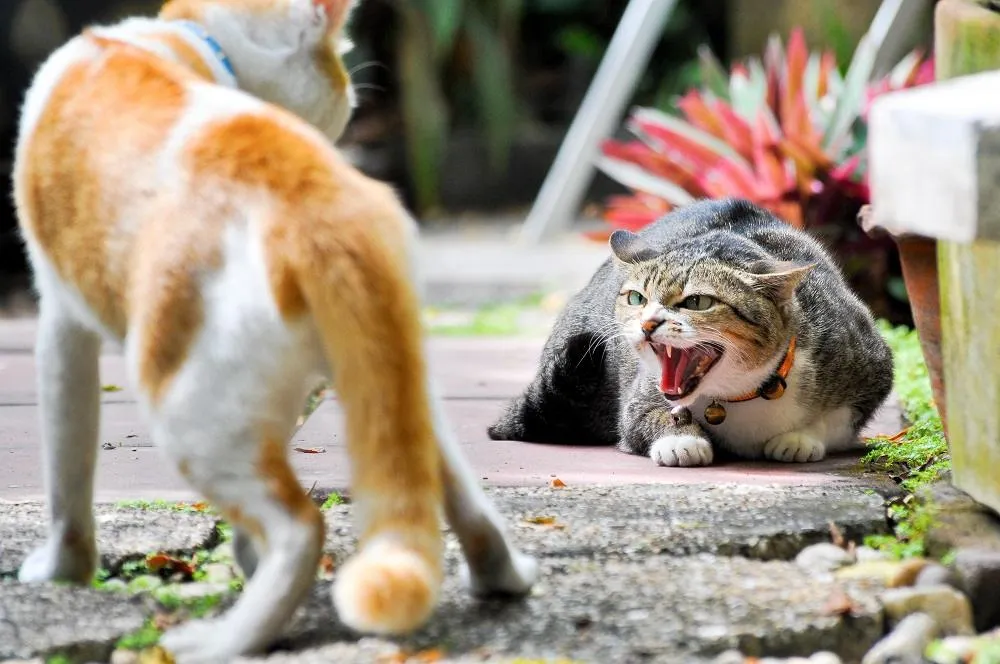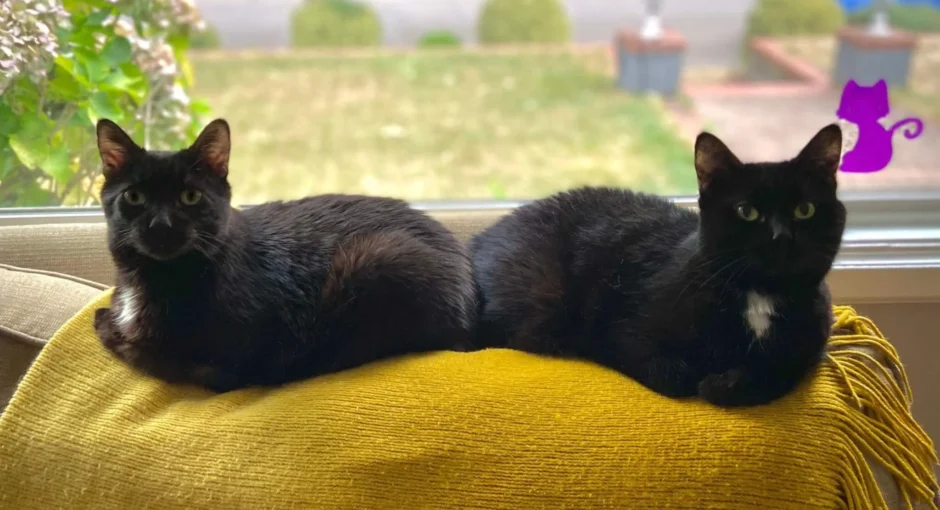Humans are naturally social and dogs are known to thrive in packs. You may wonder if your feline family members crave company from other cats too. Well, the social workings of cats can actually make some multi-cat households a little complicated.
Tension between our pets is always distressing and can be difficult to manage. Learning how to properly introduce cats and recognize the warning signs of conflict will give you the best chance for harmonious living. In this article, we’ll discuss why multi-cat living can be stressful for cats and how you can help.
Two’s a Crowd: The Social Life of Cats
Do all cats prefer to live alone? Every cat is unique but they are all territorial to some degree. Their home is very important to them and this can make group living difficult. Territories are often formed based on food availability and designed to avoid conflict with other cats. When multiple cats are forced into an enclosed area, such as a home environment, this can lead to stress and conflict if space and resources are not evenly distributed.
Felidae (the biological family encompassing all cat species) are generally solitary animals, with the notable exception of lions. However, Felis catus (the domestic cat) has evolved to be amenable to group situations, likely due to many generations of human domestication and their natural adaptability.
Feral cats often form small colonies, which are mostly based around female groups collaborating to raise their young. Relationships within these groups are often complicated. They remain solitary hunters and do not form a classic pack. Male cats are usually independent of these groups.
A 2022 study highlighted the complex nature of cat-to-cat interactions and how a huge variety of factors impact feline stress. It is difficult to find a straight answer to whether multi-cat households tend to increase stress in cats, but cat-to-cat conflict can certainly be problematic.
Also Read: Dos and Don’ts of Petting a Fearful Cat
Secrets to Success

It is possible for cats living together to form strong social bonds. MNStudio / Shutterstock
According to International Cat Care, multi-cat households don’t need to be stressful if certain safeguards are followed. Some important factors to consider when working with more than one cat include introducing a new cat to an existing one, organizing the house to ensure fair resource availability, and minimizing conflict.
Multi-Cat Introductions
The way you introduce your new cat can make or break the success of your multi-cat household. Introductions should be made gradually over the course of several weeks. Establish a private territory for your new cat, away from the main areas of your resident cat, so they each have a safe space in the home.
Start with scent-swapping, then progress to visual contact before the cats are allowed physical access to the same areas. Watch carefully for warning signs of aggression, such as fixed staring, flattened ears, swishing tails, growling, or hissing. These all mean the cat does not want to fight, but they will to protect themselves. Cats who have a successful social bond will groom each other and sleep close together.
Also Read: Wet vs. Dry Cat Food: What’s Better for Cats?
When I brought home a second cat, I took introductions extremely carefully. I set up a safe space for the new cat, Jazzy, far away from my cat Pi’s favorite spots. I gave them separate feeding areas, litter boxes, beds, hiding places, and toys so they didn’t have to compete. They had no contact at all until Jazzy had spent a few weeks settling in.
Next I spent two weeks exchanging bedding and toys between them so they had access to each other’s scent. Then I allowed them brief visual contact with a baby gate as a barrier to prevent physical contact. They seemed curious rather than fearful, so after another few weeks, I removed the baby gate. I didn’t force them to meet and they each had access to all they needed without infringing on each other’s territory. In my case, the two never formed a close social bond but they live happily in the same environment without conflict or stress.
Sharing Resources
The success of cat colonies in the wild mostly depends on the availability of key resources, such as food and shelter. So think about all your cats’ needs: food and water, litter box, snuggle spots, toys, and the good bird-watching windows. If each cat or bonded group of cats, has access to resources in their own territory, hostility should mostly be avoided.
Position food and water bowls so your cats can eat and drink without having to turn their back to their surroundings and potential competitors. Similarly, cats need to feel safe while using their litter box. Some cats may block access to litter trays as a form of passive aggression. This can lead to health problems such as bladder and bowel disease as well as anxiety. Litter boxes should be plentiful, positioned in quiet areas, and cleaned at least once a day.
Cats also need lots of sleep and access to comfortable sleeping areas where they can let their guard down. Many cats prefer elevated beds or perches where they can rest and observe without feeling threatened. Resting spaces don’t need to be expensive—most cats love a cozy blanket or even a cardboard box.
Also Read: Are Cats Smarter Than Dogs? Scientists Finally Have the Answer
Feline Pheromones
Cats use scent as a major form of communication and their intrinsic pheromones are part of this secret messaging system. Territory marking is performed using pheromones in feces and urine. It’s also done through the paw pads while scratching and through facial and flank glands when they rub themselves against objects or people.
Providing scratching posts not only helps cats fulfill their natural desire to sharpen and hone their claws, it also allows for good cat communication about their territory boundaries. Increase the chances of harmony between your cats by using pheromone sprays or diffusers, such as Feliway, to encourage pleasant messages rather than tetchy disputes.
Common Problems

Aggression between cats can be a huge source of stress. Glue Promsiri / Shutterstock.com
Having more than one cat can lead to a loving, bonded social group, but there are also some potential pitfalls. Let’s go through some common problems and how to tackle them.
Urine Spraying
Cats, both male and female, use urine spraying as a form of communication—usually about territorial borders and disputes.
If your cat leaves urine around the house, it can be difficult to tell whether it was spraying or just inappropriate toileting behavior. Spraying differs from normal urination in that it involves a small volume of strongly scented urine and is done against a vertical surface. Unless you catch them in the act, it can be difficult to say for sure. A good starting point is to have your cat checked by a vet to ensure there is no medical cause for house soiling.
If the urination seems behavioral, ensure all cats have their own safe space. Provide access to all resources without them having to go through another cat’s territory. Place scratching posts in key areas to encourage communication through scratching rather than urine marking.
Also Read: Dos and Don’ts of Petting a Fearful Cat
Cat Fights
As a veterinarian, I see cats in the clinic who have bite and scratch wounds inflicted by other cats, usually due to territorial disputes. But in general, this is not common. Cats are solitary predators who know they need to stay safe to keep providing themselves with food and shelter. They tend to have strong self-preservation instincts and want to avoid fights.
Physical conflict is a last resort, so if you observe signs of aggression between cats, you need to intervene. Separate the offending parties and ensure they each have their own resources. Then perform a slow reintroduction—just as you would introduce new cats for the first time. Synthetic pheromones may help to foster friendly feelings.
Bullying
Although cats don’t have a pack structure to their social groups, relationships between individuals can become complicated. It is not uncommon to have a bully within the group. This cat tends to take advantage of the others and can restrict access to food and water bowls, litter boxes, resting spaces, and other shared areas like catios.
Careful observation can often identify a feline bully. There may not be overt signs of aggression, such as fighting or hissing. You may witness more passive-aggressive stances, such as lying in wait at feeding times, waiting to attack after the other cat uses the litter box, or guarding a cat flap. Care should be taken so all individuals have access to their own needs without influence from other cats.





